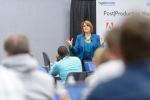It’s hard to find an organization today that’s not focused on, or at least giving lip service to, diversity. But have you ever considered the cost to your organization of not having a diverse leadership team? When Catalyst first came out with their study about the ROI for investors of companies with more diverse boards, many were surprised. But the numbers were clear: Return on Equity, Return on Sales and Return on Invested Capital were all significantly higher (53%, 42% and 66% respectively) for companies with more women on their boards.
to find an organization today that’s not focused on, or at least giving lip service to, diversity. But have you ever considered the cost to your organization of not having a diverse leadership team? When Catalyst first came out with their study about the ROI for investors of companies with more diverse boards, many were surprised. But the numbers were clear: Return on Equity, Return on Sales and Return on Invested Capital were all significantly higher (53%, 42% and 66% respectively) for companies with more women on their boards.
The same is true for nonprofit boards. Boards lacking diversity can make poor financial decisions, such as investing the bulk of their endowment with an investment manager “everyone knows.” Boards lacking diversity can miss big opportunities to reach new communities and new donors. They can miss out on creating new partnerships.
So how can you create a more diverse board?
First, let’s define diversity. When I meet with boards on this topic, everyone’s first instinct is to think ethnicity and gender. These are important. But just as vital to decision-making are having people of diverse ages, life experiences, socio-economic backgrounds, family structures, and more.
Range of Ages. The most common lack of diversity I see on boards is related to age. And the most common form of ageism I see is against younger people (which on boards tends to mean under- 35). Yet the views of the 18-35 set, and their facility with the internet and social media tools, makes them especially valuable on boards.
Varied Life Experiences. Another area where boards often lack diversity is in life experiences. That’s because so many people are recruited to boards by friends, business associates or college/grad school classmates. So if you have one corporate lawyer on your board, you’re likely to have two or more. That’s not to say anything against lawyers, but there is also diversity among types of legal expertise and it could benefit your board to have more than one kind. Life experiences also include living overseas, blended families, military families, LGBT, and religious background.
Personal Attributes. A third area for boards to focus on when attaining diversity is a mix of personal styles and personality attributes. Even if you’re board is every color of the rainbow, if every person on it is a forceful leader, you’re going to have trouble filling your committees. By the same token, if everyone is a quiet, behind-the-scenes type of operator, you’ll have trouble finding committee chairs every year. You need a mix of several personality types to make a board fully functional.
Varied Connections. Finally, board diversity requires diverse community connections. One of the most overlooked areas for recruiting board members is among the clergy. Rabbis, priests, and ministers tend to know a lot of people in their communities, as well as other organizations that are making a difference there. That makes them great “connectors” to have on your board, irrespective of whether your organization has a religious mission. Other great connectors are people who volunteer in communities in which your organization wants to reach. And also don’t overlook individuals who serve on national boards, where they make contacts all across the country.
Tapping diverse talents always leads to a stronger board. And a stronger board helps you avoid costly mistakes and deliver on your bottom line: the mission.
Amy DeLouise is a video producer/director and consultant who works primarily with nonprofits and their leadership teams.













